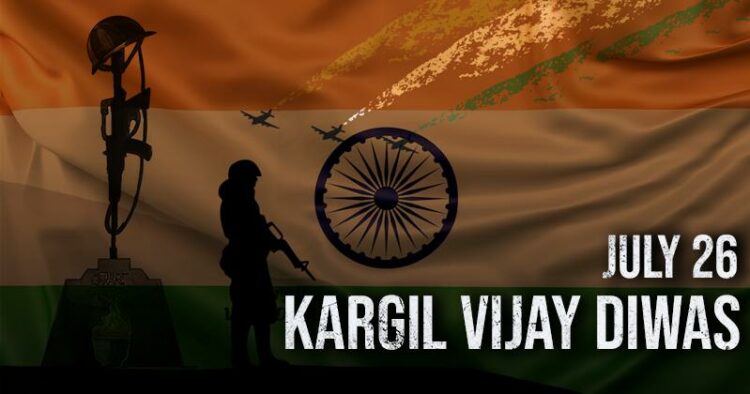The Kargil War, fought between India and Pakistan in 1999, stands as a testament to the valor, determination, and resilience of the Indian Armed Forces. Lasting for over two months, the conflict saw Indian soldiers’ brave treacherous terrain and harsh weather conditions to defend their nation’s sovereignty and territorial integrity. On this day we commemorate India’s historic victory in the Kargil War and highlights the unwavering courage of its armed forces. The day also marks the 25th anniversary of the Vijay Diwas.
The Kargil War started in May 1999 when the Indian intelligence agencies discovered that Pakistani army and terrorists had infiltrated in the Kargil region of Jammu and Kashmir. This incursion posed a severe threat to India’s strategic interests, as the enemy forces occupied vantage points along the Line of Control (LoC), allowing them to target vital supply routes and communications.
The infiltrators aimed to cut off the vital Srinagar-Leh highway, which would give them a tactical advantage in the region. The Kargil War was a result of Pakistan’s audacious attempt to seize control of the high-altitude regions in Kargil, overlooking the vital Srinagar-Leh highway.
The operation was conducted stealthily, catching India by surprise. However, our brave soldiers swiftly responded to the challenge, and what followed was a fierce and hard-fought battle in some of the harshest terrains on earth.
India’s response to this blatant aggression was swift and decisive. With a clear objective to evict the intruders and reclaim our own territories, the Indian military launched Operation Vijay.
The operation entailed a well-coordinated offensive by ground forces, artillery units, and air support.
In the Kargil war, the enemy held greater sway at a vantage situation. Pakistan Army sitting atop Tiger Hill, the highest peak in the Kargil sector, was able to monitor the movement of the military headquarters of the 56 Mountain Brigade stationed at Matayan between Ghumri and Drass. Tiger Hill also overlooks the National NH1D. NH1D, starting near Srinagar and traversing through Sonmarg, Zoji La, is a strategic route to Leh and Siachen. Occupation of Tiger Hill enabled Pakistan to monitor the movement of armed forces along this crucial Srinagar-Leh Highway. Control of Tiger Hill also brought a stretch of National Highway 1 (near Matayan – Drass) under the crosshair of Pakistani weapons.
Herculean efforts of 18 Grenadiers, 2 Naga, and 8 Sikh of the Indian Army supported by artillery units led to Indian flag fluttering high on the morning of July 3 at the top of Tiger Hill. Use of laser-guided bombs and shelling from howitzers made a march of infantry on ground easier and saved the precious lives of our soldiers. On NH1D a War Memorial has been open to public since 2014 at the foothills of Tololing overlooking Tiger Hill, Batra Top has many such stories to tell.
One of the most remarkable aspects of India’s victory in the Kargil War was the indomitable spirit of its soldiers. The rugged and mountainous terrain of Kargil posed immense challenges, making it an uphill battle both literally and figuratively. Yet, the Indian amy displayed remarkable courage and determination in engaging the enemy at close quarters, often in hand-to-hand combat. Their ability to adapt to the harsh environment and innovative tactics played a crucial role in turning the tide of the war in India’s favor.
The Indian Air Force also played a pivotal role in providing tactical support and achieving air superiority in the region. The use of advanced fighter jets, surveillance aircraft provided a significant advantage in locating enemy positions and targeting them accurately.
India’s victory in the Kargil War was not only a testament to its military prowess but also underscored its diplomatic acumen. The Indian Government successfully garnered international support for its cause, highlighting Pakistan’s terrorism and aggression and the need to restore the status quo ante along the LoC. The international community overwhelmingly backed India’s stance, forced Pakistan to withdraw its forces.
India’s victory in the Kargil War was a remarkable chapter in the nation’s military history. The victory serves as a reminder of the sacrifices made by our armed forces and their families, and it inspires us to cherish the values of unity, patriotism, and courage that are the bedrock of our nation’s strength.
The nation lost 524 soldiers while 1,363 soldiers got injured. Indian soldiers braved great odds at such high-altitude terrains which are ideal for defence while devastating for an offensive operation against well-supplied army.
The sacrifice of our soldiers will never be forgotten, and the nation remains indebted to these brave men for their unwavering commitment to safeguarding its sovereignty.
Among the many brave heroes, Captain Vikram Batra, and his famous war cry “Yeh Dil Maange More”, stand out as a shining example of courage and patriotism.
The phrase “Yeh Dil Maange More” that Captain Batra uttered during the Kargil War became synonymous with his bravery and the unyielding spirit of Indian soldiers. It later became a popular slogan and an inspiration for millions of Indians across the country. It reflected the soldier’s unquenchable thirst for victory and willingness to give their all for the nation.
The victory showcased the exceptional courage and determination of the Indian Armed Forces, who rose to the occasion and secured a hard-fought triumph against all odds. The war also reinforced India’s commitment to peace and stability in the region.


















Comments